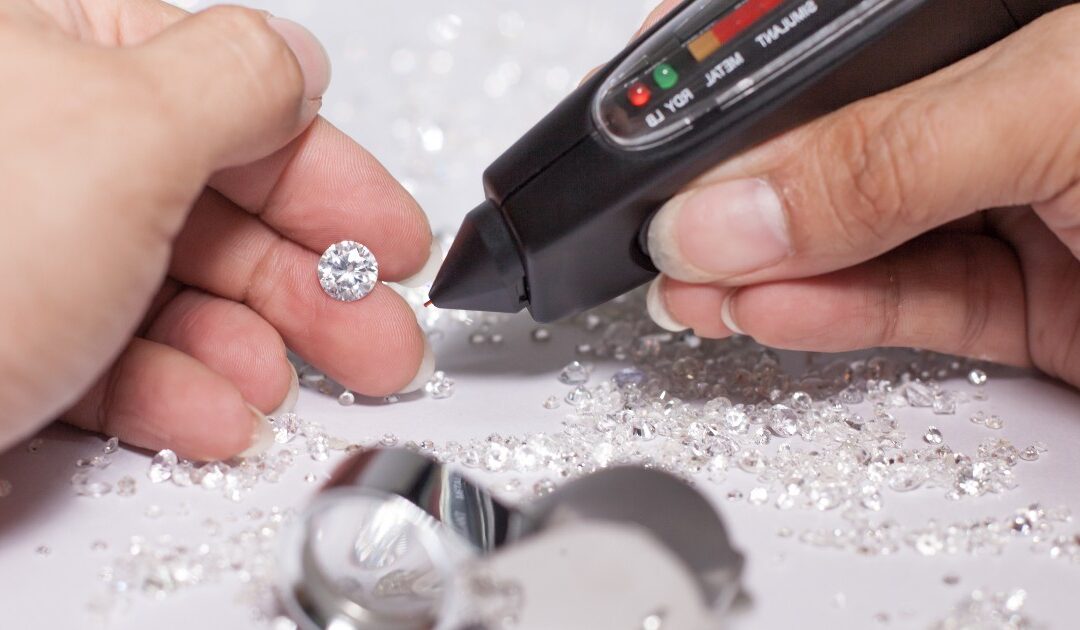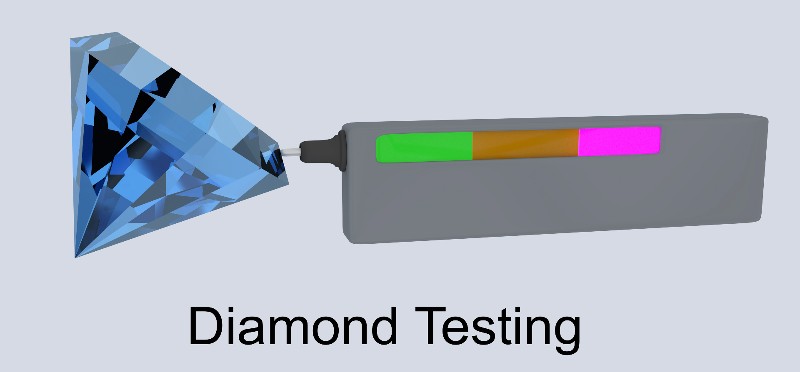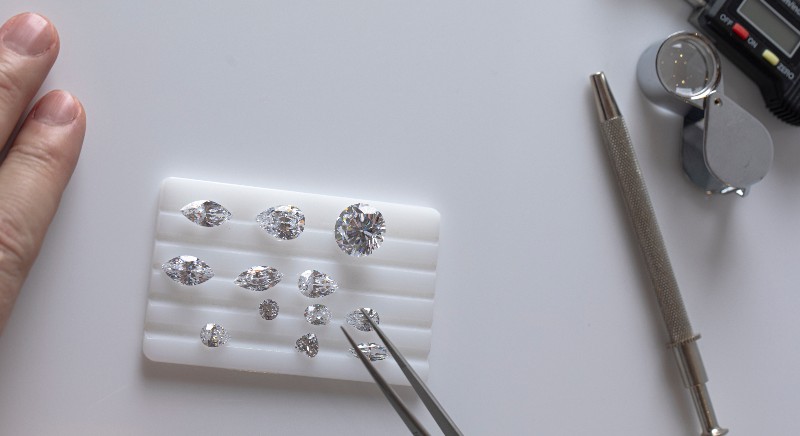Importance of Knowing If a Diamond is Real
Diamonds, as the hardest mineral on Earth, are precious, valuable, and often carry significant sentimental value. Being able to distinguish a real diamond from a fake diamond is not only a fun party trick but also a critical skill to ensure that your investment is genuinely worth it. It could mean the difference between possessing a priceless treasure and falling victim to a clever scam.
Brief Overview of the Common Methods to Verify Diamond Authenticity
Several techniques will be discussed in this blog post to test the authenticity of a diamond, both at home and with the aid of professional tools. These tests range from the simple fog and water test to the more complex refractivity and fluorescence analysis and even the exploration of the distinctive characteristics of real diamonds. With these tools in your knowledge toolbox, you’ll quickly tell a real diamond from a fake stone.
Understanding the Characteristics of Real Diamonds
Before diving into the various tests, let’s familiarize ourselves with a real diamond’s unique characteristics. Understanding these features will provide a solid foundation for determining whether a diamond is genuine or fake.
Unique Properties of a Diamond
Diamonds, a form of carbon subjected to high pressure and temperature deep in the Earth’s mantle, exhibit several remarkable properties that separate them from other minerals. The real diamond sparkle, for instance, is due to their high refractivity and light dispersion, which scatter light into a rainbow of colors.
Diamonds are also the hardest known mineral, scoring an ideal 10 on the Mohs mineral hardness scale. This means they can scratch every other mineral, a feature that is often employed in the scratch test.
The Role of the 4Cs (Cut, Clarity, Color, and Carat) in Identifying Real Diamonds
The 4Cs – Cut, Clarity, Color, and Carat, are crucial factors to consider when distinguishing a real diamond from a fake one.
- Cut: The cut refers to the diamond’s proportions, symmetry, and polish. It dramatically affects the diamond’s sparkle. Light will be reflected beautifully by a well-cut diamond, while a poor cut may make even the highest-quality diamond look dull.
- Clarity: Real diamonds often have tiny imperfections or inclusions, usually not found in most fake diamonds.
- Color: Most diamonds have a slight yellow hue, but the most valuable diamonds are colorless.
- Carat: This refers to the diamond’s weight. A larger carat typically means a more valuable diamond, but the size is only part of it. The other three Cs are equally important.
Overview of Synthetic and Imitation Diamonds
In our exploration of real diamonds, it’s important to note that there are also synthetic diamonds and diamond imitations. Synthetic diamonds or lab-grown diamonds are chemically, physically, and optically identical to natural diamonds. Still, they’re created in a lab instead of being formed on the Earth over billions of years.
Conversely, diamond imitations such as cubic zirconia and moissanite look like diamonds but are made from different materials. They don’t have the same physical and chemical properties as real diamonds, making them easier to identify with the tests we discuss.
Basic Methods to Test If a Diamond is Real at Home
You might be surprised to learn that there are several simple ways to test if a diamond is real at home. While these methods are partially foolproof, they can help determine whether a diamond is authentic or not.
When determining whether a diamond is genuine, one of the best methods is to look at its clarity, or the “true diamond,” which involves a series of diamond tests. From the sparkle test to the dot test, newspaper test, and light test, many methods are available for testing diamonds. You must understand that real diamonds sparkle differently than their substitutes, such as cubic zirconia and white sapphire.
This unique shine of natural diamonds sets them apart, thereby helping in identifying a real one from fakes. Now, if you’re looking at a diamond ring with a type of gold, say, the quality of the setting can sometimes corroborate white gold or platinum, the authenticity of the diamond. Most jewelers often use platinum or gold for setting flawless diamonds, as they enhance the stone’s brilliance.
Before you carry out these tests, start with a close inspection of the stone in front of you. When examined closely, real diamonds often have minor imperfections, while many synthetic diamonds and cubic zirconia are typically perfect. Keeping this in mind is also crucial that many jewelers suggest the “loose stone” method for more accurate results.
In this method, loose diamonds are used eliminating the chance that the stone shatters during testing. Further, diamond substitutes like white sapphire might fool the untrained eye with their luster, but rest assured, an authentic diamond has a unique sparkle that differentiates it from all other stones. Consulting with a reputable jeweler, like Diamond Exchange Houston, or visiting a jewelry store to verify your diamond’s authenticity is always a wise step, as these professionals have specialized tools for verifying diamonds, which can give a more precise result. Remember, these tips are meant to provide an authentic diamond look and not fall for fakes masquerading as the real deal.
The Fog Test
The fog test is a popular home test for diamonds due to its simplicity. Hold the diamond or ring close to your mouth to perform this test and fog it up with your breath, just like a mirror. A real diamond clears up quickly, while a fake one remains foggy for a bit longer. This is because diamonds are influential heat conductors and disperse heat rapidly.
The Water Test
The water test is another quick and straightforward method to determine a diamond’s authenticity at home. Drop the loose diamond or stone in question into a glass of water. If it sinks, it’s likely a real diamond, as diamonds have high density. If it floats or hovers beneath the surface, it’s probably not a real thing.
The Read-Through Test
For the read-through test, you need a newspaper or a piece of white paper with clear, black lettering. Place the diamond, flat side down, onto the text. If you can read the text while looking through the diamond, it’s probably not real. Due to their high refractivity, real diamonds distort light so much that you shouldn’t be able to see clearly through them.
Checking for Imperfections
Remember the clarity part of the 4Cs? Real diamonds usually have tiny imperfections, which can be viewed under a magnifying glass. This makes checking for defects a valuable method to distinguish between genuine and fake diamonds. It might be too good to be true if the stone is perfect and has no blemishes or inclusions.
The Heat Test
Diamonds are incredibly resilient and can withstand high heat, while many fake diamonds cannot. Hold the stone with pliers for the heat test and heat it up over a lighter flame for about 40 seconds. Then drop it immediately into a glass of cold water. A real diamond won’t react to this extreme temperature change, but a fake stone might shatter.
Importance of Multiple Tests for Accuracy
While these home tests are handy, they’re only sometimes 100% accurate. Some high-quality fake diamonds might pass these tests. So, it’s best to conduct several tests and consult a diamond expert or jeweler for confirmation.
Advanced Techniques for Identifying Real Diamonds
An in-depth look at the science of diamond identification for those interested, there are more advanced techniques to determine if a diamond is real. These methods involve specialized tools and knowledge.
Use of a Loupe to Identify Inclusions and Blemishes
A jeweler’s loupe is a specialized magnifying glass to inspect gemstones and jewelry. Using a loupe can reveal tiny inclusions or blemishes in the stone, often present in real diamonds but not in most fake ones.
Understanding the Refractive Index and How Diamonds Refract Light
The refractive index measures how much light a substance can bend. Diamonds have a high refractive index, meaning they bend light to a significant degree, contributing to their brilliance. The bottom facet won’t be visible from above in a real diamond because it will uniquely refract the light. Instead, you’ll observe a reflection of its top aspect.
Understanding Fluorescence and How It’s Used to Identify Diamonds
Some diamonds exhibit a characteristic known as fluorescence when exposed to ultraviolet light or black light. This means they emit a soft colored glow, often blue, which can be a clue to the diamond’s authenticity. However, not all real diamonds show fluorescence, so this alone isn’t a conclusive test.
Introduction to Professional Tools – Diamond Testers, UV Light, etc.
Several professional tools can aid in diamond identification. For instance, a diamond tester can measure the heat conductivity of the stone in question to determine if it’s a real diamond. Another tool, a UV light, can check for fluorescence in the diamond.
Role of a Professional Gemologist in Diamond Verification
Despite the various at-home methods and professional tools available, nothing beats the expertise of a professional gemologist in diamond verification. Gemologists have extensive training in identifying and grading gemstones and can definitively answer whether a diamond is real or fake.
Pros and Cons of Buying Diamonds Online
As online shopping becomes more prevalent, buying diamonds on the internet is becoming more common. If you are considering purchasing diamonds online, here are a few things to consider.
Common Concerns About Diamond Authenticity Online
The biggest concern when buying diamonds online is authenticity. You need to see the diamond in person to be sure it’s real and not fake.
How Online Retailers Assure Diamond Quality
Reputable online retailers usually provide comprehensive information about each diamond’s 4Cs and offer a grading report from independent organizations like the Gemological Institute of America (GIA) or the American Gem Society (AGS). These reports confirm that the diamond has been professionally evaluated and verify its quality and authenticity.
Importance of GIA or AGS Certification When Buying Diamonds
When purchasing a diamond, primarily online, looking for GIA or AGS certification is crucial. These certifications provide an unbiased quality assessment and assurance that your diamond is genuine.
Risks of Fake Diamond Scams Online and How to Avoid Them
Despite these measures, the risk of fake diamond scams remains. To avoid them, buy only from reputable retailers, look for GIA or AGS certification, and consider getting the diamond appraised independently after purchase.
Conclusion
Being able to tell if a diamond is real is a valuable skill that can help protect your investment and ensure you get the real deal. From understanding the unique properties of diamonds and the 4Cs to performing home tests to seeking help from a professional gemologist, there are many ways to verify a diamond’s authenticity.
Final Thoughts:
Before making a diamond purchase:
- Ensure you’re armed with the knowledge to verify its authenticity.
- Feel free to share your experiences or ask questions about identifying real diamonds.
- Remember, a genuine diamond isn’t just a symbol of luxury—it’s also a testament to the remarkable wonders of nature and the enduring value of authenticity.





